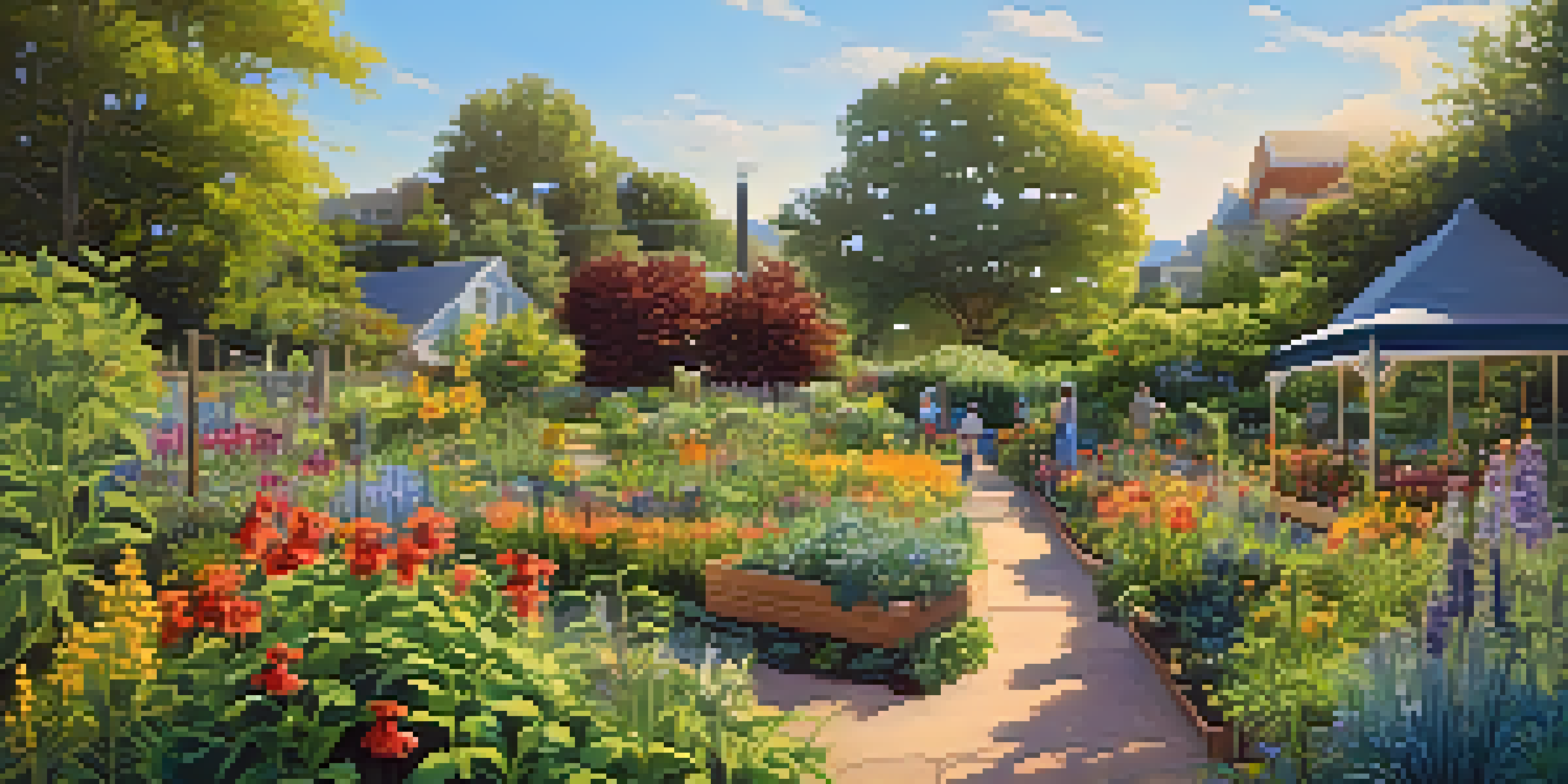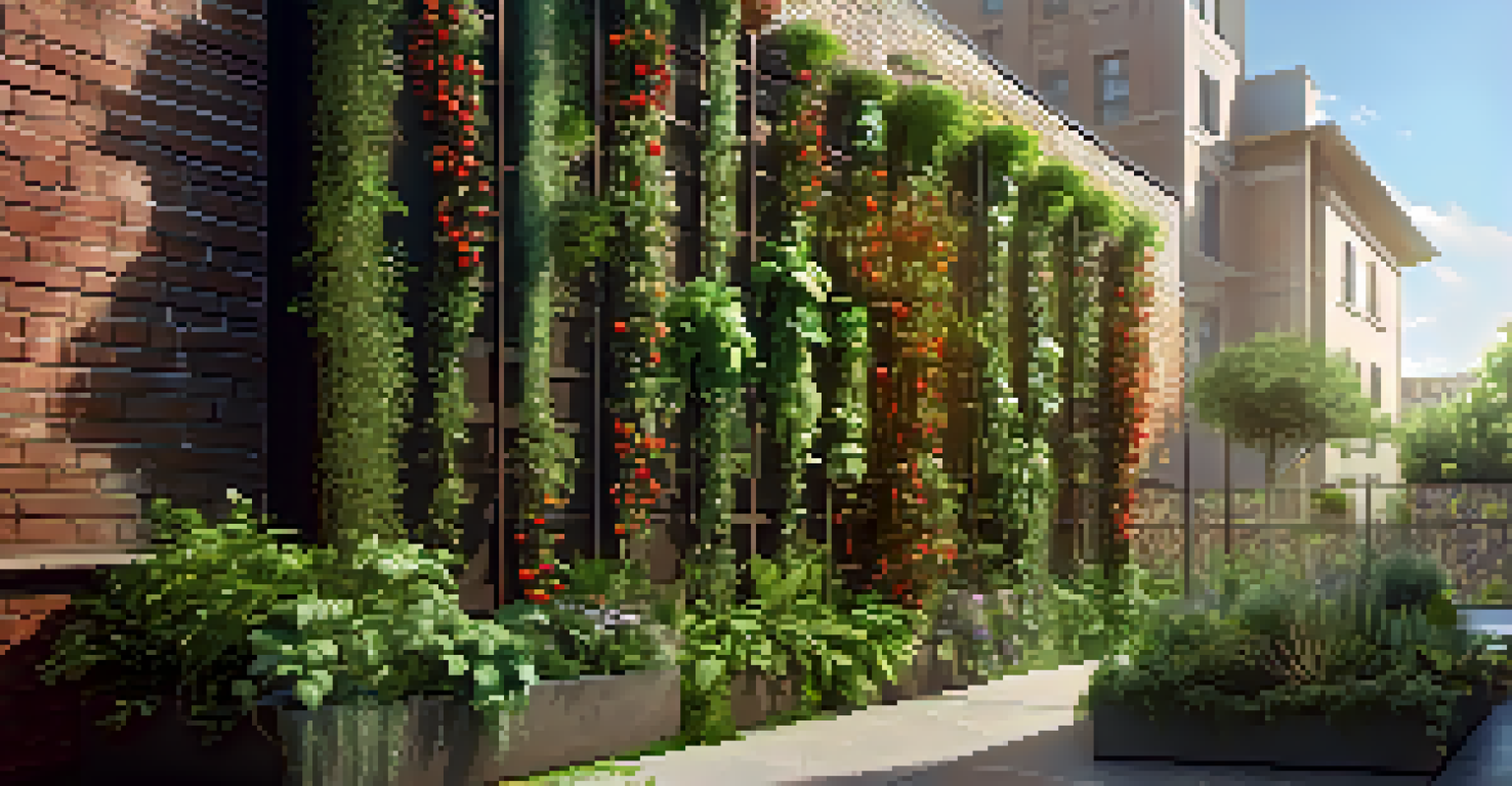Inspiring Landscaping Ideas for Community Gardens

Transforming Spaces with Native Plants
Using native plants in community gardens not only supports local wildlife but also reduces maintenance. These plants are adapted to the local climate, meaning they require less water and care, making them a sustainable choice. For instance, incorporating wildflowers can attract pollinators like bees and butterflies, enhancing the garden's ecosystem.
In every walk with nature one receives far more than he seeks.
Imagine walking through a garden filled with vibrant colors and buzzing bees—this is the beauty that native plants can bring. They create a sense of place, connecting the community to its natural heritage. Plus, they often come with the bonus of being drought-resistant, helping conserve water.
By choosing native plants, community gardens can thrive with minimal intervention, allowing volunteers to focus on other creative projects. Think of it as planting a garden that gives back to the environment while beautifying the neighborhood.
Vertical Gardening: Maximizing Small Spaces
In urban areas where space is a luxury, vertical gardening offers an innovative solution. By utilizing trellises, wall planters, or even repurposed wooden pallets, gardeners can cultivate a variety of plants without needing a large footprint. This approach not only saves space but also adds visual interest to the garden.

Picture a wall covered in lush greenery with tomatoes climbing up one side and herbs cascading down the other. Vertical gardens can turn blank walls into vibrant living canvases, making the most out of every square inch. They also promote community involvement as residents can contribute to maintaining these vertical structures.
Native Plants Enhance Gardens
Using native plants not only supports local wildlife but also reduces maintenance and conserves water.
Moreover, vertical gardening can encourage healthier eating. When fresh vegetables and herbs are easily accessible, community members are more likely to incorporate them into their meals. This elevates not just the garden's aesthetics but also the community's overall well-being.
Creating Gathering Spaces with Seating Areas
A community garden is more than just a place to grow food; it’s a space for connection. By adding seating areas—like benches or picnic tables—gardens can become inviting spots for neighbors to gather, share stories, and enjoy nature. These social spaces can enhance community bonds and encourage more frequent visits.
The greatest threat to our planet is the belief that someone else will save it.
Envision a cozy corner of the garden where families can enjoy lunch together or friends can gather for a book club. Incorporating seating not only makes the garden more functional but also fosters a sense of ownership among community members. It turns the garden into a hub of activities and interaction.
To create these gathering spots, consider using materials that blend seamlessly with the natural surroundings—like reclaimed wood or stone. This thoughtful design adds charm while promoting sustainability, making the garden a true reflection of the community's values.
Incorporating Edible Landscaping Features
Edible landscaping is a fantastic way to combine beauty and function in community gardens. By integrating fruit trees, berry bushes, and edible flowers into the landscape, gardens become not only visually appealing but also productive. Imagine walking through a garden where you can snack on ripe strawberries or pluck fresh herbs!
This approach promotes an understanding of where food comes from, encouraging healthier eating habits within the community. Additionally, edible plants can serve as attractive focal points, drawing visitors’ attention and inspiring them to explore the garden further. It’s a delicious way to engage the community.
Vertical Gardens Maximize Space
Vertical gardening transforms small urban spaces into vibrant green areas, encouraging community involvement and healthier eating.
Moreover, edible landscaping can be a fun, interactive experience for all ages. Workshops on how to care for these plants can bring people together, fostering a sense of community while providing learning opportunities about sustainable practices.
Adding Color with Seasonal Flower Beds
Seasonal flower beds can bring a splash of color to community gardens, making them more inviting and lively. By planning for blooms throughout the year, gardeners can ensure that there’s always something visually stunning to enjoy. A vibrant mix of annuals and perennials can create a dynamic landscape that changes with the seasons.
Imagine walking through a garden where spring brings tulips, summer bursts with sunflowers, and autumn showcases chrysanthemums. This colorful rotation not only enhances beauty but also attracts more visitors, who may be curious about the latest blooms. The visual appeal can significantly increase community engagement.
In addition to their aesthetic value, flower beds can also support pollinators and beneficial insects, contributing to the overall health of the garden. By selecting a variety of flowers that bloom at different times, community gardens can create a continuous cycle of life and color.
Sustainable Practices: Composting and Rainwater Harvesting
Sustainability is key in creating a thriving community garden, and incorporating composting and rainwater harvesting can make a significant impact. Composting helps recycle kitchen scraps and garden waste, turning them into nutrient-rich soil amendments. This not only reduces waste but also enhances soil health, leading to better plant growth.
Imagine a compost bin bustling with activity, turning organic material into gold for the garden. It’s a practical way to engage community members in sustainability practices while improving the garden's productivity. Workshops on composting can also educate residents on waste reduction strategies.
Community Engagement Through Workshops
Educational workshops in community gardens foster connections among residents while empowering them with valuable gardening skills.
Rainwater harvesting complements this effort by providing an eco-friendly way to water the garden. By collecting rainwater in barrels, communities can reduce their dependence on municipal water sources. This practice not only conserves water but also showcases the importance of sustainable resource management.
Engaging the Community with Educational Workshops
Educational workshops can play a vital role in the success of community gardens. Hosting events on gardening techniques, sustainability practices, or cooking demonstrations can foster a sense of community while empowering individuals with valuable skills. These gatherings provide a platform for sharing knowledge and fostering connections among residents.
Picture a sunny Saturday where families gather to learn about planting techniques, followed by a cooking class featuring garden-fresh ingredients. Such experiences can enhance community spirit and encourage participation in the garden’s upkeep. They also create opportunities for collaboration and creativity.

Furthermore, educational workshops can cater to all age groups, ensuring everyone feels included. By fostering a culture of learning and sharing, community gardens can thrive as educational hubs that promote not only gardening skills but also environmental awareness.